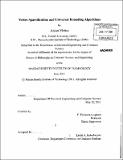Vertex sparsification and universal rounding algorithms
Author(s)
Moitra, Ankur
DownloadFull printable version (6.853Mb)
Other Contributors
Massachusetts Institute of Technology. Dept. of Electrical Engineering and Computer Science.
Advisor
F. Thomson Leighton.
Terms of use
Metadata
Show full item recordAbstract
Suppose we are given a gigantic communication network, but are only interested in a small number of nodes (clients). There are many routing problems we could be asked to solve for our clients. Is there a much smaller network - that we could write down on a sheet of paper and put in our pocket - that approximately preserves all the relevant communication properties of the original network? As we will demonstrate, the answer to this question is YES, and we call this smaller network a vertex sparsifier. In fact, if we are asked to solve a sequence of optimization problems characterized by cuts or flows, we can compute a good vertex sparsifier ONCE and discard the original network. We can run our algorithms (or approximation algorithms) on the vertex sparsifier as a proxy - and still recover approximately optimal solutions in the original network. This novel pattern saves both space (because the network we store is much smaller) and time (because our algorithms run on a much smaller graph). Additionally, we apply these ideas to obtain a master theorem for graph partitioning problems - as long as the integrality gap of a standard linear programming relaxation is bounded on trees, then the integrality gap is at most a logarithmic factor larger for general networks. This result implies optimal bounds for many well studied graph partitioning problems as a special case, and even yields optimal bounds for more challenging problems that had not been studied before. Morally, these results are all based on the idea that even though the structure of optimal solutions can be quite complicated, these solution values can be approximated by crude (even linear) functions.
Description
Thesis (Ph. D.)--Massachusetts Institute of Technology, Dept. of Electrical Engineering and Computer Science, 2011. Cataloged from PDF version of thesis. Includes bibliographical references (p. 125-129).
Date issued
2011Department
Massachusetts Institute of Technology. Department of Electrical Engineering and Computer SciencePublisher
Massachusetts Institute of Technology
Keywords
Electrical Engineering and Computer Science.